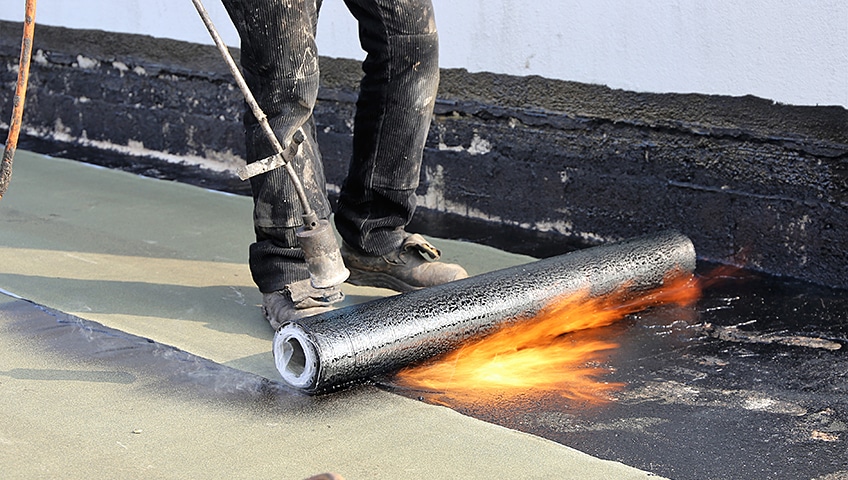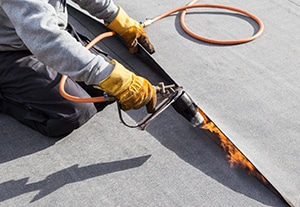
A Complete Guide to Built-Up Roofing Systems
April 10, 2021
Built-up roofing systems are one type of roofing system you can have for your facility. Commercial roofing contractors generally apply built roofing when the work is required. When you are looking for help for your roofing system, start with commercial roofing contractors near me as a means to select a contractor with a solid reputation, certifications and licensing to perform the work.
A built roof is one of the most common roofing systems in commercial operations – they have been in service for well over 100 years and saw growth in the 1970s as the go-to roofing system in commercially operated buildings. It is still used today, and it holds many advantages for a commercial structure. At Integrity Roofers, we have a lifetime of experience servicing commercial roofs. We want to educate the consumer when it comes time to make an important decision about the building they operate.
Types of Built-Up Roofing
Ballasted Asphalt Built-Up
This roofing system is joined or anchored to the roof membrane. It uses a layer of gravel over the decking. At first blush, building owners were concerned that high winds could remove the layer of coverage exposing the underlayment. Large stones that are affixed with plates and fasteners secure the deep layer of gravel from moving. Installation is simple as the stones are blasted onto the roof, and it can be installed under any conditions.
Hot Built-Up
Liquefied materials are used when this system is installed, and it can be troublesome because the roofers are working with heated materials.
Cold Built-Up
Roofing materials are applied with a squeegee or a spray during the installation process. It poses no toxicity problems, and changes in the weather are no deterrent to applying this roofing system.
How Do Built-Up Roofing Systems Work?
The BUR system is the progeny of the asphalt roofing method when installed. It is created through layers of the membrane with bitumen and reinforcing agents added along the way to provide structural integrity. The system is standard for low-sloped roofing systems or flat roofing systems that are used for commercial buildings. The installation process, in a nutshell, sees asphalt, tar, or a cold adhesive spread across the roof deck. Roofing felts are placed next, with a fibreglass layer rolled along the deck. The last thing added is an aggregate for durability and a reflective coating to deflect UV rays is the last line of defence for the roof.
The Benefits of Built-Up Roofing
- Built-up roofing systems offer many advantages, including:
- Top-notch waterproofing
- Best use of space
- UV ray protection
- Fire-retardant
- Virtually maintenance-free
- Economical when compared to other roofing systems
A roofing system that has been around for over 100 years has many things going for it, and a BUR is durable in the face of harsh weather outcomes. Bitumen and tar are the critical ingredients for a BUR, and the addition of fibreglass makes them almost impenetrable to even the worst weather conditions. As we mentioned, the membrane construction is tough as nails, and it requires little in the way of regular maintenance. Still, as the primary asset of your building, you will want to inspect your roofing system at least twice a year for any problems that come about due to weather or debris. When installing a BUR, know that you will be adding a layer of protection for your roof. That protection comes in the form of a reflective coating that keeps the building cool and deflects UV rays from your facility. BUR is one system that repels leaks well, and the added layers of protection are where the water resistance comes from.
Built-Up Roofing Repair & Maintenance
When the time comes for repairs and maintenance for a built-up roofing system, getting the coating right is the first imperative. The coating protects your roof from harmful UV rays that will create unforeseen damage to a roofing system. If left unchecked, UV rays can make thousands of dollars in repairs or, worse yet, a complete roof replacement at your facility. Roof coating is a different animal from waterproofing – it won’t stop water leaks inherent in all roofing systems from time to time. The place where leaks stop on the roof is at the flashing. You need to maintain adequate maintenance protocols and correct installation of the roofing system to keep water out. If you decide to short-change your roofing system by not installing UV reflective coating, you can expect your roof to deteriorate quickly and quietly. Water leaks will start, and your repair expenses will soar.
Coating a roofing system is careful, meticulous work; you need to prepare the roofing system before applying the material and weather conditions must be right for a successful application. It starts with a roof inspection to detail any problems that require resealing due to leaks repair or remove flashing that is damaged or aged out, and cracks and gaps must be closed before the process starts. Once these conditions are spoken to, you need to thoroughly clean the roof’s circumference before the coating material is applied. Certainly, UV coating is an expense that many of us would like to avoid – why spend money when we don’t have to? But like everything in life, the Devil is in the details.
First and foremost, when spending thousands of dollars on a new roof, you want to get maximum shelf life from your investment. The UV coating will ensure that your roof will last for more than 30 years. When applying UV coating, understand that it will last for a maximum of six years – remember that that the pounding your roof takes from UV rays is intense, and it will burn a roof to a crisp if there is nothing to stop the rays from frying your roofing system. To keep your roof in the best possible condition you can, employ a roofing contractor on a maintenance plan – they will inspect your roof at least twice a year and detect minor problems before they become substantial repair bills.
Contact Us for All Your Built-Up Roofing Needs

Before we start work on the roof, we will inspect the entire roofing system, not just where you think the problem is occurring. Once we accumulate digital evidence, we will present it to a building owner with our recommendations to solve the problem. From there, our crew will attend to your location with everything they need to prosecute your roofing problem, and they answer any questions you may have along the way. Roofing problems have solutions, and when you call our office at Integrity Roofers, know that your problems are our problems. For a detailed consultation that comes with a professional estimate, call our office today at Integrity Roofers at 647.953.9365.
Also Read:



















